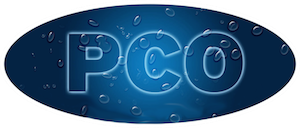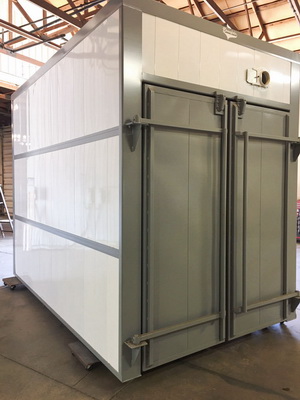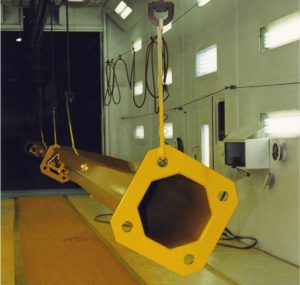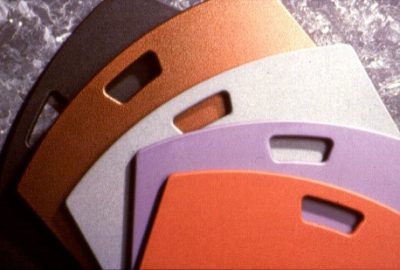Before applying the powder coating material you must first consider the substrate material that you will be coating. It is very important to have a clear understanding of the true composition of the surface of the part. The word substrate means; a part, substance, element etc. which lies beneath and supports another; foundation.
Before processing any part it is first necessary to distinguish between the “True Surface” and the “Apparent Surface”. The exact composition of the surface must be known in order to select the proper pretreatment process as well as the correct cure and temperature cycles.
The “True Surface” is the actual surface that the coating material will come into immediate contact with. The “Apparent Surface” is what you think you are coating over. For example: Powdercoating over what may be polished brass may surprise you if the material has a water based clear coat that cannot be seen. The apparent surface was polished brass, the actual surface was water based clear coating.
The following is a brief explanation of some of the most common materials that are powder coated today.
ALUMINUM: A silvery metallic chemical element. It is remarkable for lightness, malleability, and resistance to oxidation. Atomic weight = 26.97, atomic number = 13. Melts @ 659.7 degrees C, or approx. 1220 degrees F. Pretreatment recommendations for maximum corrosion resistance is chem-film or chromate conversion coating. Aluminum heats up quicker than steel in a standard convection oven. This may allow cure process of the powder to happen in less time resulting in higher line speeds for high production applications.
ALUMINUM CASTING: Aluminum in its molten state is poured into a form and allowed to solidify and form the desired part configuration. Pretreatment recommendations are the same as above. Special care in processing may be necessary if the casting material has trapped contaminants or air pockets. Overcoming these types of problems may involve special powder formulations and/or special application techniques.
DIE-CASTING & SAND CASTING: Die casting is generally done under pressure, whereas, a sand casting is simply poured into the compressed sand impression mold as is. The pressure injected die-casting process is less porous than the sand-casting process and subsequently produces less problems than occur by outgassing during the post curing cycle of the powder coated finishing process.
ALUMINUM and ZINC METAL SPRAY: The process of metal spraying, also called spray metalizing, consists of applying a protective metal coating to the surface of a steel substrate. The application spray gun is constructed so that aluminum powder or wire is fed to the gun, where it is heated to a molten state. These molten droplets of aluminum are propelled via nitrogen gas and compressed air towards the desired surface and fuse together to form a protective aluminum coating at a predetermined thickness. Metal spraying utilizing portable equipment is frequently used for metal build up on warn parts in field repairs. Only recently has this process been utilized in the form of corrosion protection as a base material for applications in extreme corrosive environments. (reference, Alumaseal-90 Corrosion Protection by Metal Flame Spray)
COLD ROLLED STEEL: The most common of the metals encountered by the jobshop powdercoater, this product is roll formed to a close tolerance and a fine surface finish, suitable for stamping, forming, and moderate drawing operations. This material can be bent flat upon itself without cracking. Good base for phosphate conversion coating. Pretreatment recommendations are Clean, Phosphate, rinse, and seal or deionize rinse.
HOT ROLLED STEEL: A low carbon steel suitable for forming, punching, welding, and shallow drawing. Surface has normal mill scale that must be mechanically or chemically removed prior to the application of any conversion coating or any organic topcoat. This mill scale adheres weakly to the metal and forms a layer between the desired finishing material and the steel substrate. Thus, the total adhesion properties of the finish over mill scale would depend on the weak adhesion of the mill scale to the base metal.
HOT ROLLED STEEL PICKLE AND OIL: A low carbon material from which the mill scale has been removed by acid pickling. The light oil is applied after the acid pickling to prevent corrosion from forming on the steel. This material has a smooth surface, suitable for stamping, drawing, and pretreatment prior to coating.
CAST IRON: A hard unmalleable pig iron made by casting: contains between 6-8 percent impurities, including a high proportion of carbon, and is very fluid and fusible when molten. Melts at 1200 degrees C, or approx. 2190 degrees F.
BRASS: A yellowish metal that is an alloy of copper and zinc. Melts at 900 +or- degrees C. Highly polished brass resembles gold, however, this material will tarnish rapidly when exposed to the environment. A clear coating applied over this polished surface will reduce this tarnishing effect to a degree. Problems are often encountered when powdercoating a clear finish over this material when the copper to zinc ratio is increased. The copper has a tendency to turn the bright polished gold look to a semi-dull reddish appearance when exposed to accelerated cure temperatures commonly used in the powdercoating process. To overcome this problem one must reduce the maximum temperature that the part is heated to. This will result in a longer cure time at a lower temperature. Proper cure of the finish material must be achieved or the coating will fail.
COPPER: A Reddish-brown malleable, ductile, metallic element that is an excellent conductor of electricity and heat. Symbol = Cu, atomic weight = 63.54, atomic number = 29. Melts at 1083 degrees C, or approx. 1980 degrees F.
LEAD: A heavy, soft, malleable, bluish-gray metallic chemical element used for piping and in numerous alloys and compounds. Symbol Pb, atomic weight = 207.21 atomic number = 82. Melts at 327.4 degrees C. or 621 degrees F. This metal cannot be processed with conventional powdercoating materials due to the low melt temperature of the metal. Problems are often encountered when parts such as light fixtures are coated that are constructed of brass and have LEAD/TIN solder holding the fixture together. The solder will soften and sometimes melt at the cure temperature required by most powdercoating materials. A possible solution here would be to construct the fixture with silver solder which has a much higher melt temperature.
ZINC: A bluish-white, metallic chemical element, usually found in combination, used as a protective coating for iron, as a constituent in various alloys, as an electrode in electric batteries, and in the form of salts in medicines. Symbol Zn atomic weight = 65.38 atomic number = 30. Melts at 419.5 degrees C, or approx. 790 degrees F.
ZINC CASTING: Zinc in a molten state is poured into a form and allowed to solidify and form the desired part configuration. The zinc material used in this process is sometimes a poor quality alloy of zinc and can cause outgassing problems. If the molten zinc or zinc alloy cools too rapidly while it is injected into the mold form it may cause partial solidification which in turn may produce air entrapment that will cause outgassing and/or blistering when the entrapped air expands during the heated cure cycle of the coating process.
ZINC PLATING: Many types of zinc plating surfaces are available in a variety of thicknesses. Some will readily accept the organic coating and some will not. The zinc material itself generally does not cause any problems but watch out for the brighteners, wax seals, and other products that are used to prolong the time in which oxidation of the zinc finish occurs.
The application of any zinc coating as a base coat prior to the application of an organic coating provides sacrificial protection as well as the barrier protection that is given by the organic topcoat. This type of additional protection is also offered by the application of aluminum and zinc by metal spray. It is important to communicate to the zinc plater or metal supplier that you intend to pretreat and apply an organic coating to the surface.
PAINTLOCK – ELECTROGALVANIZED: Produced by electrolytically depositing zinc on cold rolled steel sheets, then chemically treated to assure maximum coating adherence to the surface. The smooth, light gray, thin, pliable coating of zinc permits forming and fabricating operations without peeling or flaking. This material is excellent for the powdercoating application. Just enough zinc is applied to offer the sacrificial protection that is needed if the integrity of the coating is broken, yet the thin even coating of high quality zinc is consistent and free of porosity that is common in heavy deposits of zinc such as hot dipped galvanizing.
HOT DIPPED GALVANIZING: As mentioned this application is generally of the lowest quality zinc alloy. The thickness of the application is very difficult to control. It is common for the plater to melt wax on the surface of the molten zinc to reduce the amount of harmful vapor fumes that are given off from the zinc. This wax substance is often deposited onto the parts when they exit the molten zinc bath. This wax residue will not be removed by conventional power washing methods.
STAINLESS STEEL: There exists many types of stainless steel alloys that vary in chemistry and properties. Most of which are not effected by the pretreatment chemicals that are commonly used in pretreatment systems. Therefore, one can only expect to achieve degreasing on this substrate unless the preparation includes mechanical treatment such as blasting or shot peening. Mechanical pretreatment will result in a better surface for the organic material to bond to physically.
A few metal related terms that you should be familiar with are:
SUBSTRATE: From (substratum) meaning; a part, substance, element, etc. which lies beneath and supports another; foundation.
ALLOY: To reduce the purity of (a metal) by mixing with a portion of one less valuable. To mix metals so as to form an alloy. Example; Zinc and Copper to form brass.
CASTING: That which is cast in a mold; anything that is formed by pouring a liquid into a hollow form and allowing it to harden or solidify; especially a metal piece so formed.
You do not have to be a metallurgist to do metal finishing, although it does help to continue to educate yourself about the different metals and their properties. Ask your metal suppliers or metal fabricators to assist you in learning more about metals. Never stop learning.
Related Resources
- Building Environment Enclosures
- Engineered Buildings
- Powder Coaters Corner
- Powder Coating Industry Research
- Contact
Powder Coating Substrate Considerations








